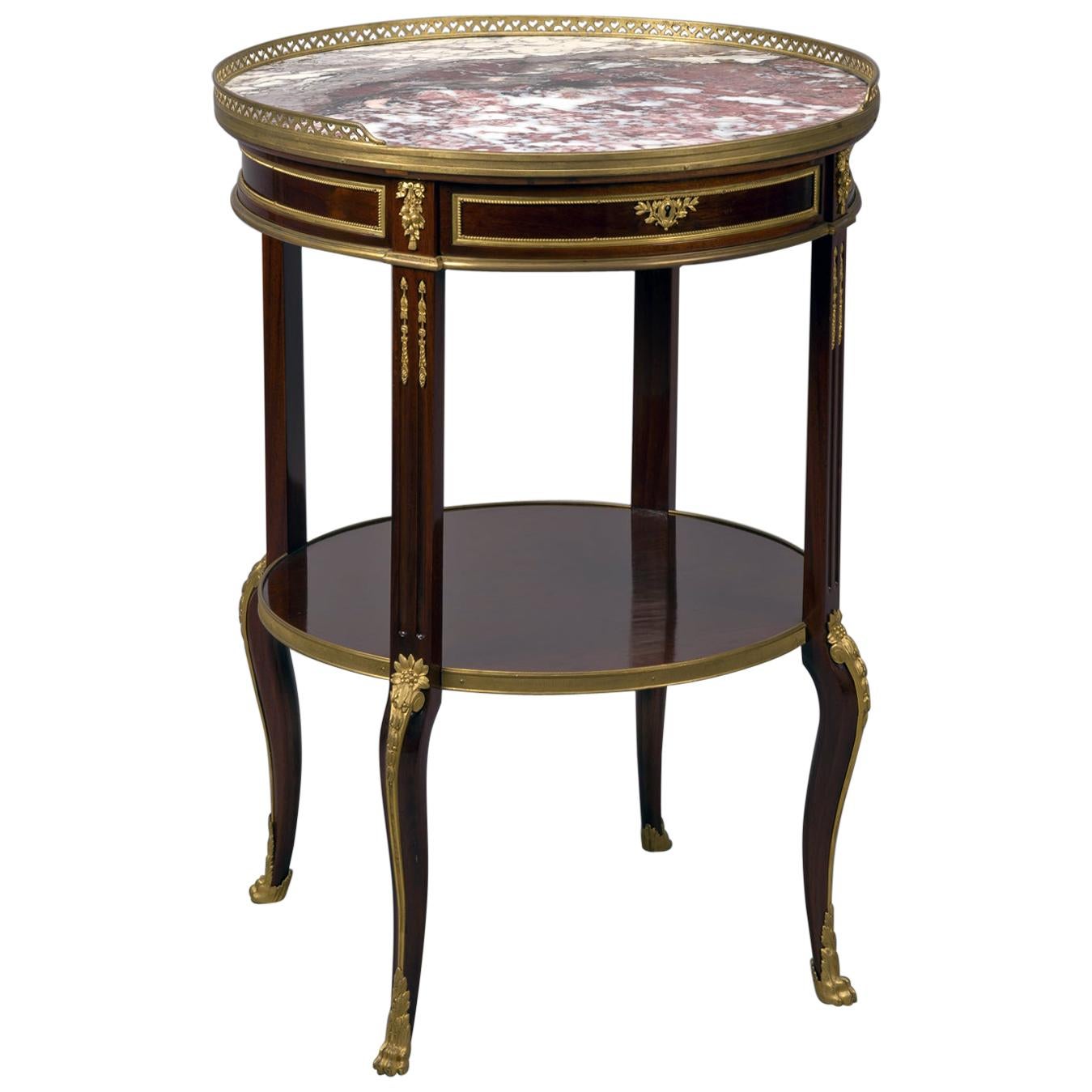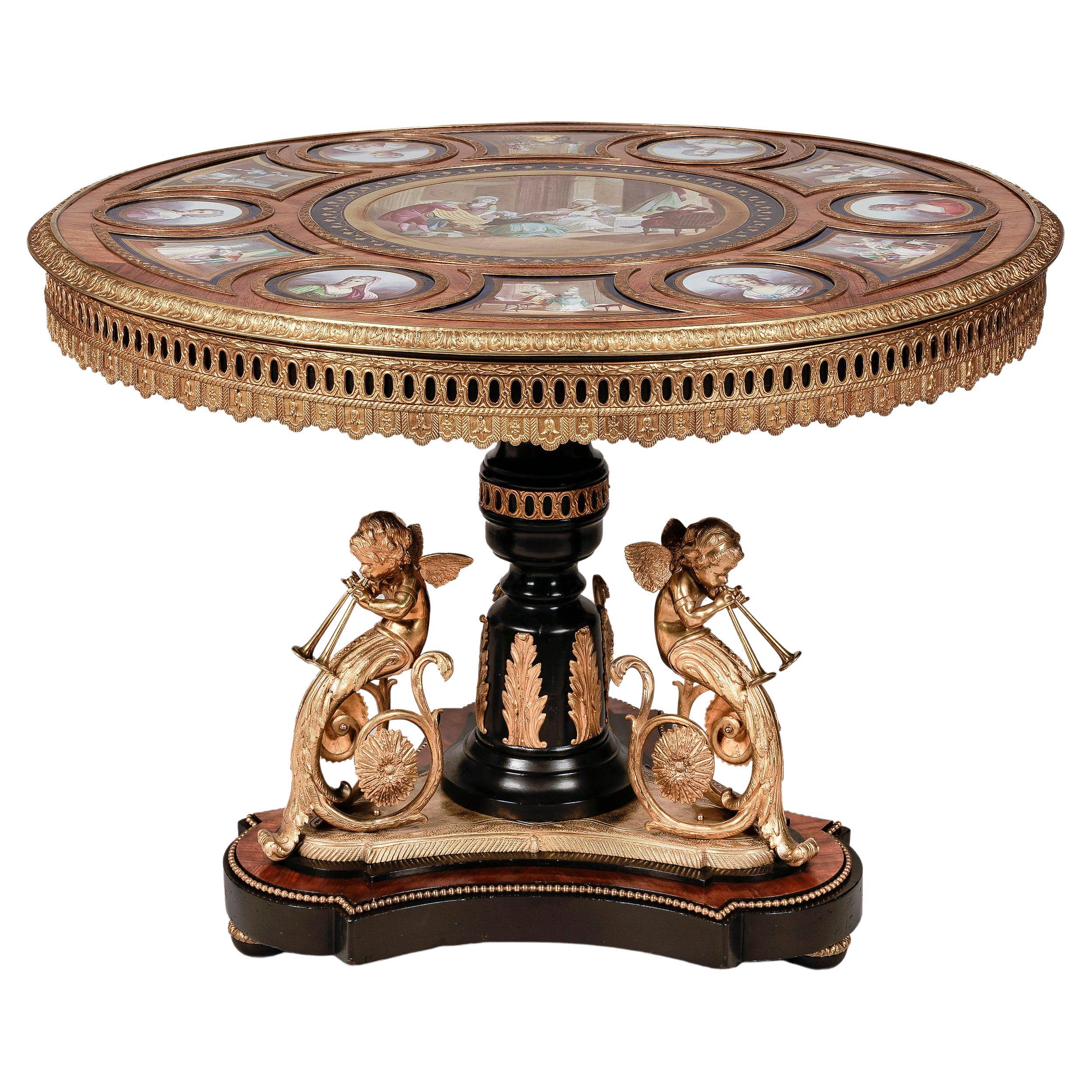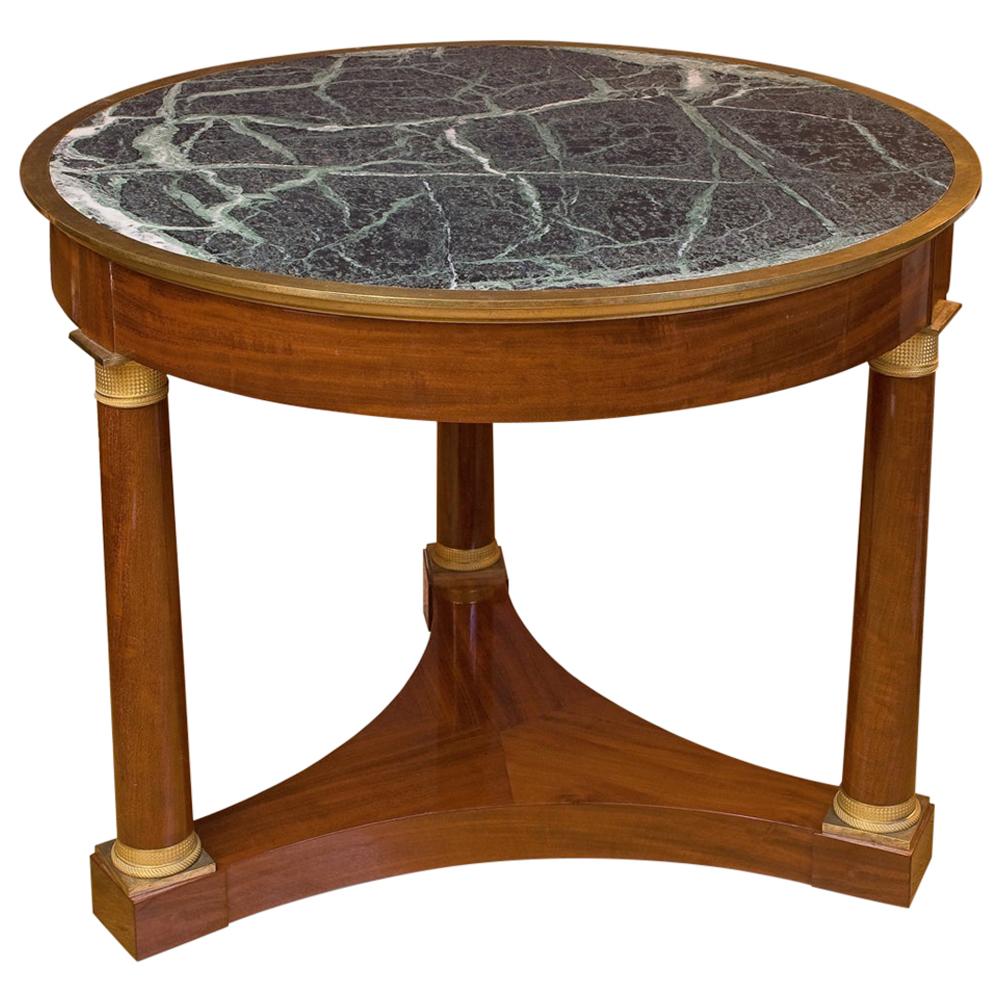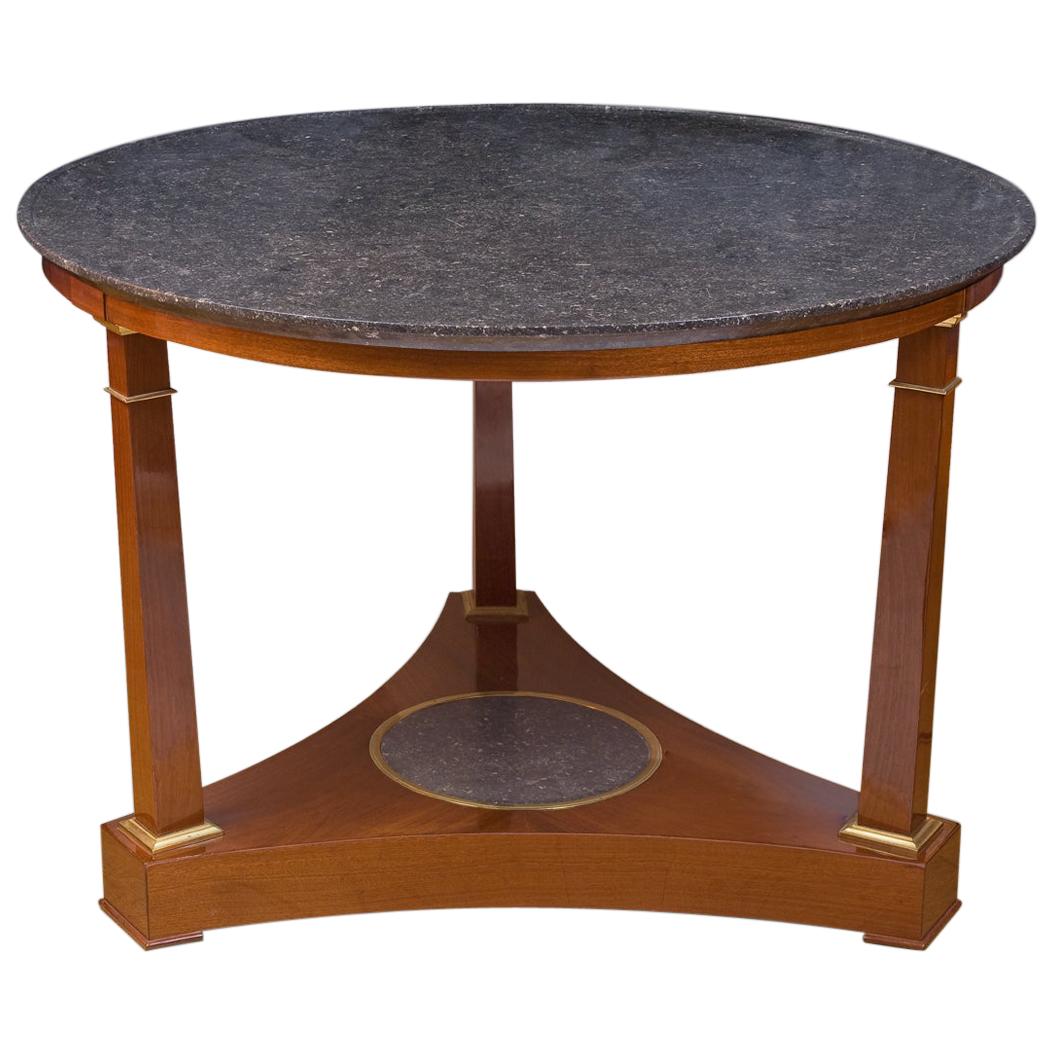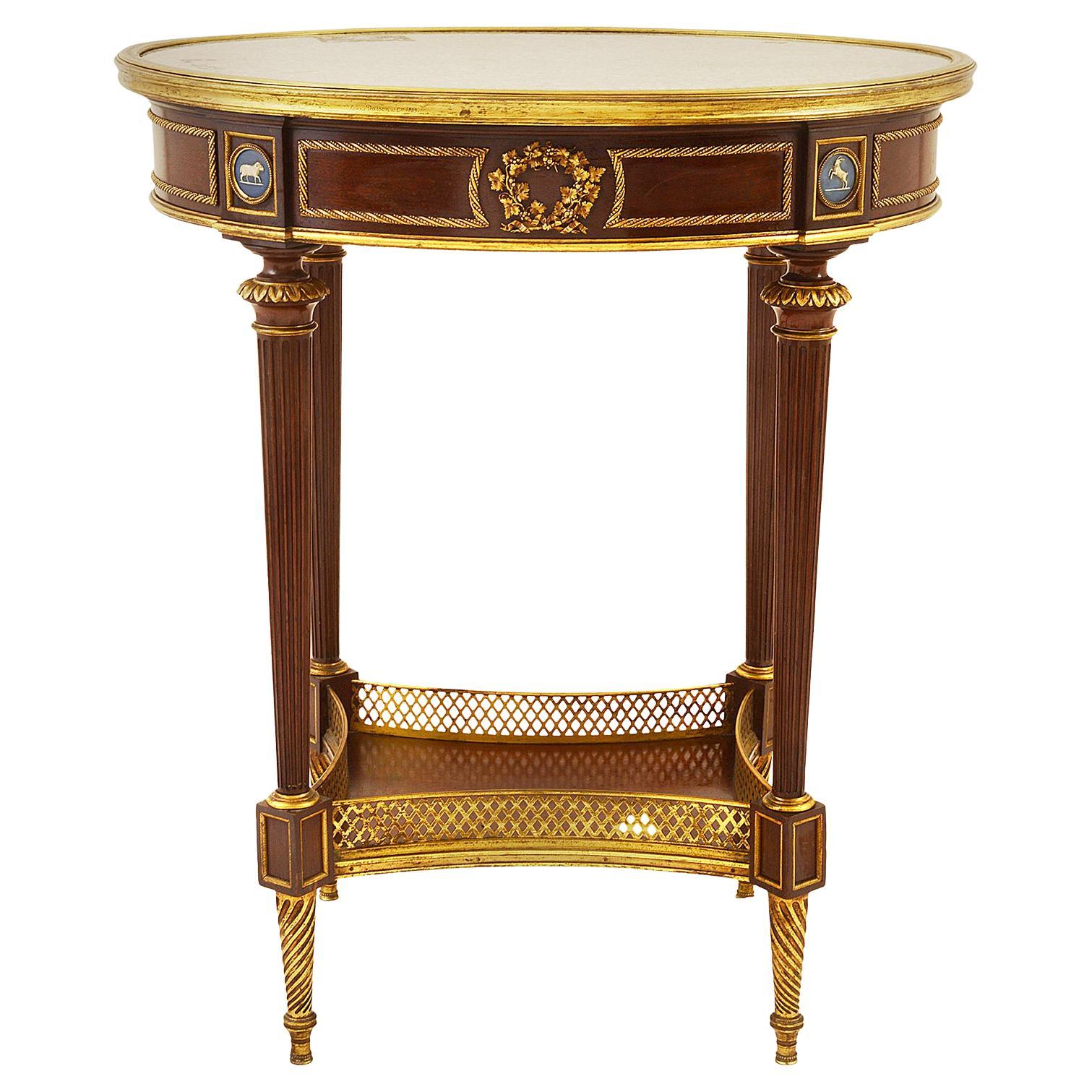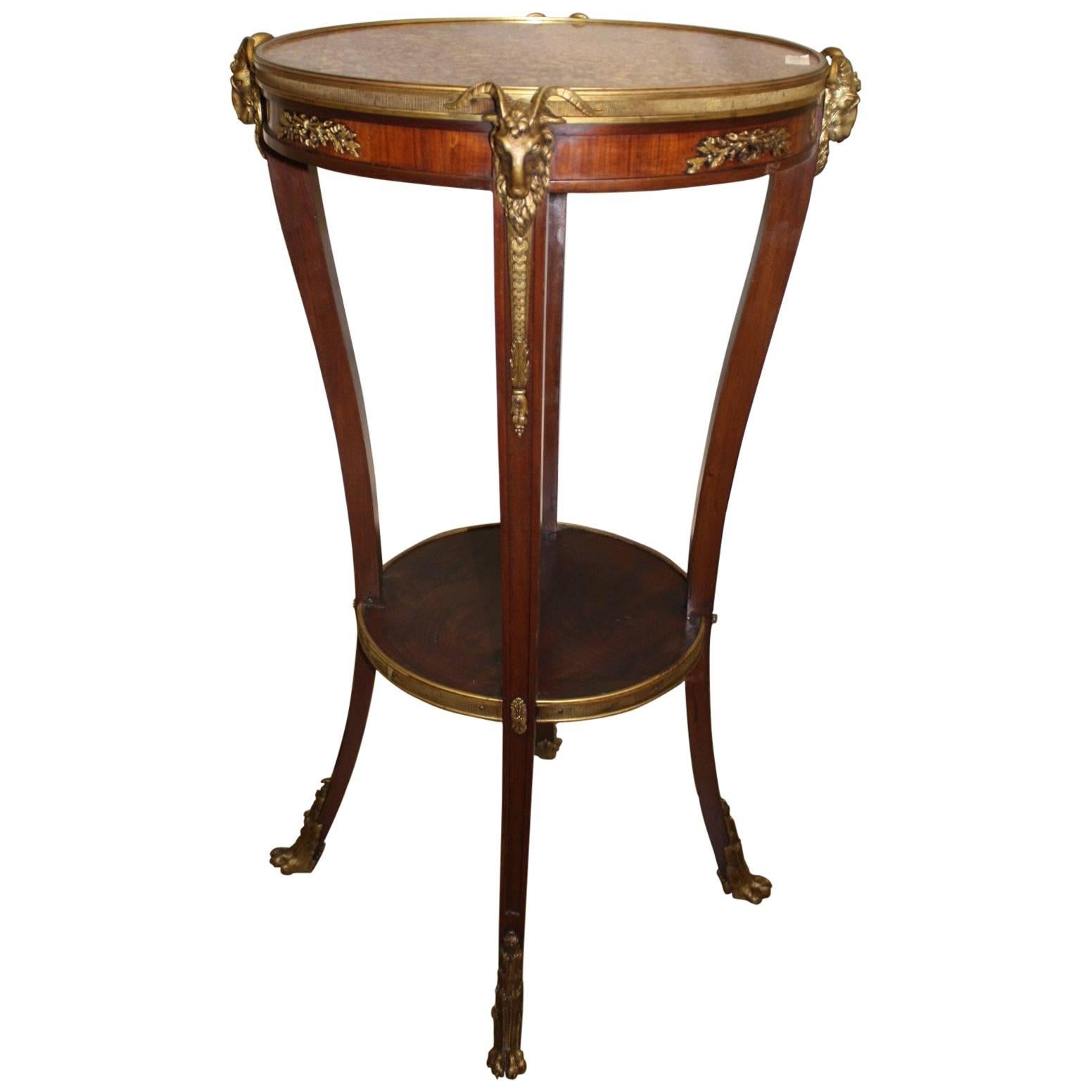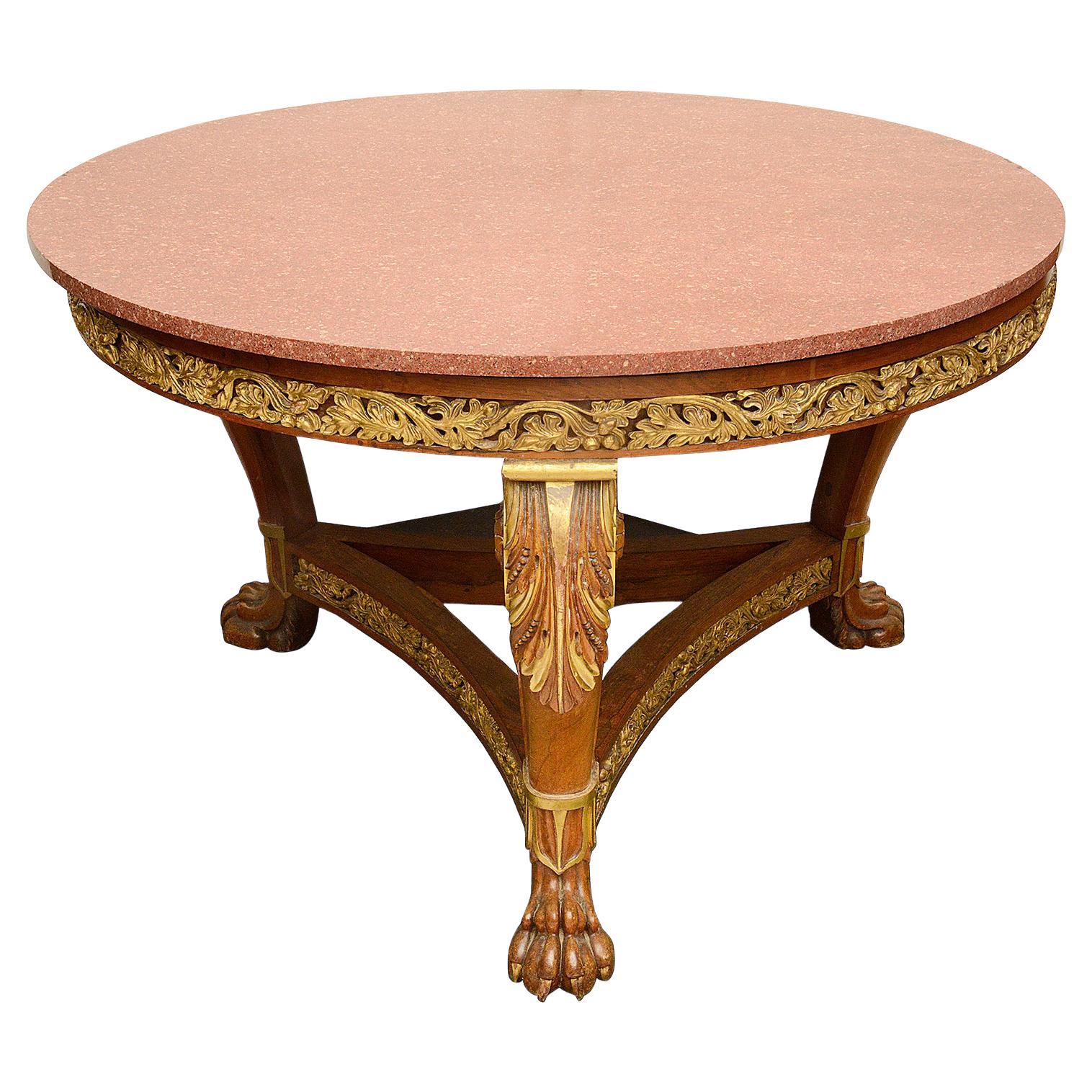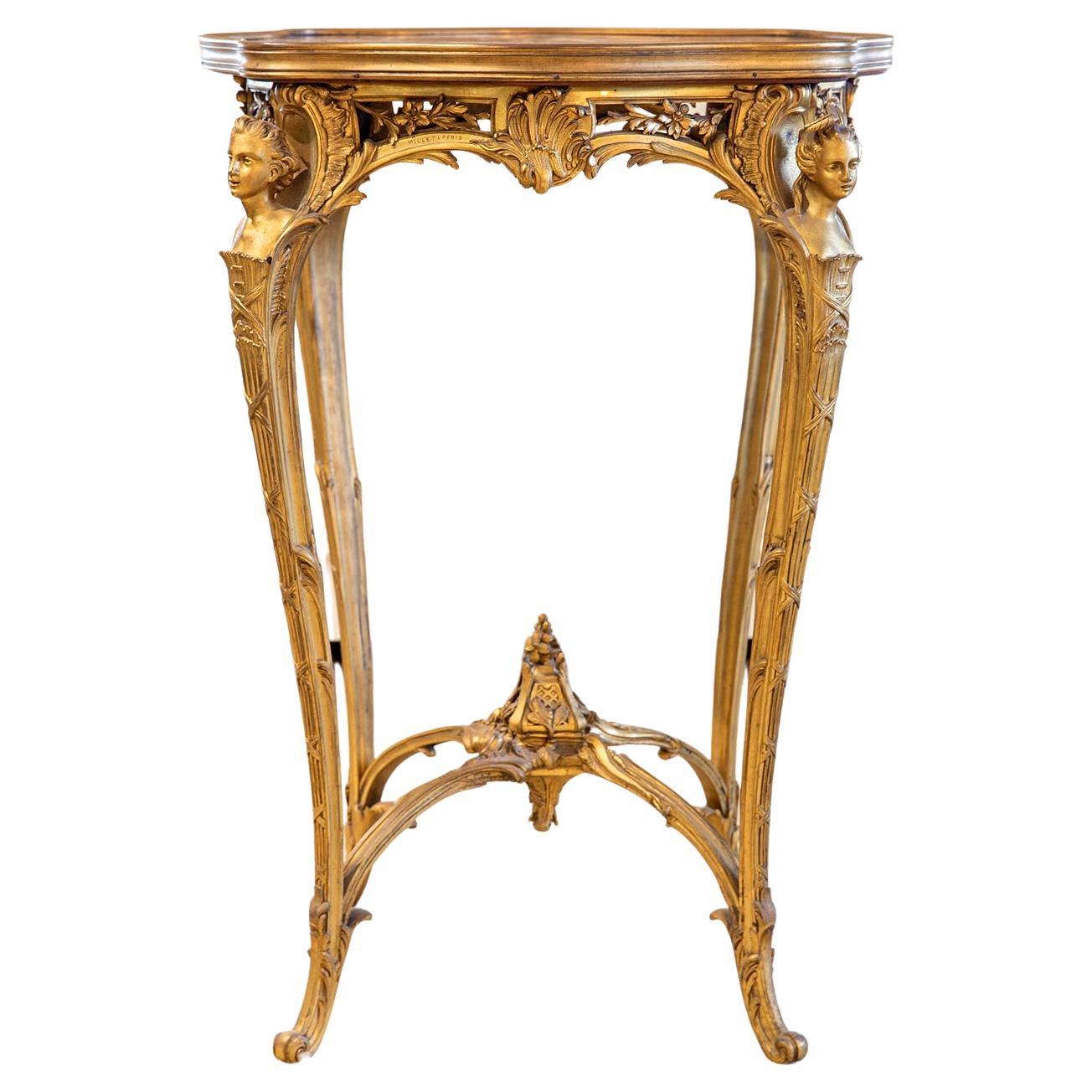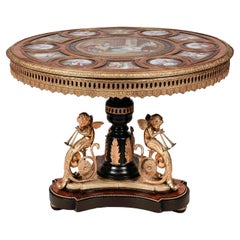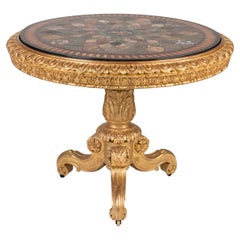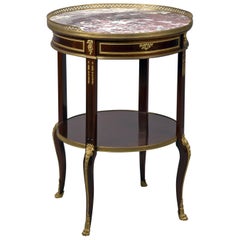
19th Century Empire Style Amboyna Gueridon Table attributed to Maison Millet
View Similar Items
Want more images or videos?
Request additional images or videos from the seller
1 of 7
19th Century Empire Style Amboyna Gueridon Table attributed to Maison Millet
About the Item
- Attributed to:Maison Millet (Cabinetmaker)
- Dimensions:Height: 32 in (81.28 cm)Diameter: 39 in (99.06 cm)
- Materials and Techniques:
- Place of Origin:
- Period:
- Date of Manufacture:circa 1870
- Condition:Repaired: Each item has undergone careful inspection and restoration by a conservation specialist in order to guarantee the original quality and integrity of the object. Wear consistent with age and use.
- Seller Location:London, GB
- Reference Number:Seller: 96481stDibs: LU954726478412
About the Seller
5.0
Recognized Seller
These prestigious sellers are industry leaders and represent the highest echelon for item quality and design.
Gold Seller
These expertly vetted sellers are highly rated and consistently exceed customer expectations.
Established in 1964
1stDibs seller since 2012
41 sales on 1stDibs
Typical response time: 2 hours
Associations
The British Antique Dealers' AssociationLAPADA - The Association of Arts & Antiques Dealers
More From This SellerView All
- 19th Century Gueridon Centre Table with Sèvres Style Porcelain PanelsLocated in London, GBA superb gueridon centre table. with sèvres style porcelain panels. Constructed from bois noirci and kingwood with mercury fire gilded ornament, the central support rising from a...Category
Antique 19th Century French Center Tables
MaterialsOrmolu
- Rare 19th Century Grand Tour Marble Top Table on Giltwood BaseLocated in London, GBA superb Specimen marble centre table The Top attributed to Alfonso Cavamelli of Rome Inspired by the Roman mosaics discovered at the ...Category
Antique 19th Century Italian Grand Tour Center Tables
MaterialsMalachite, Marble, Porphyry
- Mid-19th Century Amboyna Octagonal Centre TableBy Johnstone, Jeanes & Co.Located in London, GBA good centre table by Johnstone & Jeanes of London Constructed in amboyna, with extensive marquetry inlays in specimen woods, and enhanced with parcel-gilt highlights. Rising from a cruciform platform base adorned with knops and having concealed castors, supporting the inlaid, and gently stepped and tapering centre column with stylized 'c' form brackets bracing the octagonal top, the outer guard band having English roses inlaid at the angles, with foliates with the national emblems of Scotland and Ireland, thistles and shamrocks. Stamped by the makers to the underside, 'Johnstone & Jeanes 67 Bond Street'. circa 1845 Published in “British Furniture 1820 to 1920” by Christopher Payne, 2023, p. 131, illustrated fig. 3.21. Johnstone, Jeanes & Co John Johnstone of Bond Street came to prominence after his collaboration with Robert Jupe, an 'upholder' of 47 Welbeck Street, Cavendish Square, London, who patented a remarkable design for a circular expanding dining table with a segmented top in 1835. After Jupe's death, the firm traded as 'Johnstone and Jeanes' from 1842 until 1880, having moved to 67 Bond Street and continuing the tradition of producing high quality furniture. After 1880, the company was re-named Johnstone & Norman. They exhibited at the Great Exhibition 1851, The International Exhibition of London in 1862, and The Paris Exhibition of 1878. Both the Royal Collection Trust and the Victoria & Albert Museum own stamped pieces of furniture in their collections. The company of Crace were designers and decorators to the Royal household from 1768 until 1899, working for every monarch from George the Third...Category
Antique Mid-19th Century English Center Tables
MaterialsAmboyna, Wood
- 19th Century Coromandel and Inlaid Table Attributed to Jackson & GrahamBy Jackson & GrahamLocated in London, GBA magnificent library table Attributed to Jackson & Graham Of free standing rectangular form, constructed in coromandel, with inlays in thuya, ebony, boxwood, and honeysuckle; the fluted legs rising from square brass castor-shod feet; the frieze housing two lockable drawers fitted with rare ‘tamper proof’ Chubb locks and having quadrant moulded cedar lined interiors; the platform having a central panel of beautifully chosen matched coromandel veneers, with an outer guard border of a running pattern of stylised anthemions; the ebony edges having a thumb nail moulding, circa 1865 The firm of Jackson & Graham established in 1836 by Thomas Jackson and Peter Graham at 37 Oxford Street London, and for the next fifty years produced predominately high quality furniture and represented Britain at many of the international exhibitions. Their clients included Queen Victoria, Napoleon III, the Grand Khedive of Cairo and the royal palace in Siam. They were particularly noted for their fine marquetry work, the use of Wedgwood plaques, rare woods, and fine casting of bronze mounts. They engaged the leading designers of the period, inter alia, Owen Jones, Bruce Talbert, Alfred Lorimer and Eugene Prignot. In the mid-1850s the workforce was recorded as 250, and by 1875, the company was employing 600 workers. They were feted exhibitors at many of the Great Exhibitions of the 19th century, and frequent prize winners. At the Paris International Exhibition of 1878, the furniture jury noted of them ‘ the workmanship is so perfect that even with the aid of a magnifying glass scarcely the slightest imperfection is to be found’. In 1885 the company was absorbed by Collinson and Lock, who continued their standard of excellence. Charles Chubb was apprenticed as a blacksmith before starting business as a ships’ ironmonger in Winchester. Jeremiah soon joined the business, and by 1818 the brothers had branched out into lockmaking, founding the famous Chubb Company. The business really got started when Jeremiah Chubb patented his new ‘detector lock’ in 1818. The lock was constructed so that if someone tried to pick it or open it with the wrong key it became inoperable. To make the lock work again the owner had to use a special key supplied with the lock. The aim of the detector lock was to prevent burglaries, and to warn the owner that someone had tried to break into their property. The lock soon became popular, and sales of the Chubbs’ products increased even more when they won a government competition to design a lock that could only be opened using its own key. After the invention of the detector lock, the Chubbs decided to move to Wolverhampton, which already had an established lock making industry. By 1838 they were making 28,000 locks a year at their Wolverhampton factory. Another product was added to the Chubb range in 1835 when a patent was taken out for a burglar resistant safe, and in 1837 the Chubb safe...Category
Antique 19th Century English Tables
MaterialsBrass
- 19th Century Italian Micro-Mosaic Grand Tour Table Attributed to RoccheggianiBy Cesare RoccheggianiLocated in London, GBA rare grand tour table Possibly by Cesare Roccheggiani The circular platform of marmore nero, inset with fine micromosaic panels consisting of thousands of coloured glass tesserae; a central roundel depicting The Vatican from St Peter's Square within a malachite border, surrounded by a border including four cartouches in polychrome reserves of Roman views including the Coliseum, the Roman Forum, with the remnants of the Temple of Vespasian; the Temple of Vesta, and the Pantheon, all interspersed and linked by voluminous bouquets of fruit and flowers representing the 4 seasons; the outer stylised border inlaid with deep blue tesserae evocative of exotic Lapis Lazuli. Supported on a finely carved Italian giltwood base, its design incorporating baskets of fruit and floral garlands echoing the 4 seasons theme of the table. Italian, Circa 1875 Other table tops inspired by this design, although not as finely executed, can be found in several Russian collections (which house the greatest micromosaics) including Vorontsov Palace, Muranovo House, as well as the imperial State Hermitage Museum. A tabletop with profuse floral micromosaic work was commissioned by the Belgian Royal family (sold Sotheby's, 2003). The floral garlands, the magnificent quality of the inlay and the use of distinct curved tesserae support the present attribution to Cesare Roccheggiani. According to Jeanette Hanisee Gabriel, the world expert on micro mosaics, curved tesserae pieces were used in foliage, grass and animal fur by only the very best mosaicists such as Roccheggiani. Evidence of curved pieces, for instance, is observed in the foreground of the Temple of Vesta cartouche, to name but one observation of the master's hand. The scion of a dynasty of mosaicists, Roccheggiani was perhaps the most successful mosaicist in the last quarter of the nineteenth century. He is doubtless related to Lorenzo Roccheggiani, a late eighteenth-century master mosaicist at the Vatican, whose work included the altarpiece, Crucifixion of St. Peter after Guido Reni. Nicolo Roccheggiani, possibly Lorenzo's son, was also a principle artist at the Vatican, involved in executing the famous tabletop Achilles Shield...Category
Antique 19th Century Italian Grand Tour Center Tables
MaterialsMalachite, Marble, Belgian Black Marble
- 19th Century 'Grand Tour' Marble Top Table with Base attributed to TrotterBy William TrotterLocated in London, GBAn Impressive 'Grand Tour' Specimen Marble Top Centre Table The base attributed to William Trotter of Edinburgh Constructed in a finely patinated mahogany, with a Florentine Pietra ...Category
Antique 19th Century Italian Grand Tour Center Tables
MaterialsAgate, Lapis Lazuli, Malachite, Marble, Breccia Marble, Porphyry
You May Also Like
- Transitional Style Guéridon by Maison MilletBy Maison MilletLocated in Brighton, West SussexA fine transitional style gilt bronze mounted guéridon with a Breccia marble top, by Maison Millet. The reverse of the gilt bronze stamped 'MB' for Maison Millet. The table has...Category
Antique 19th Century French Gueridon
MaterialsMarble, Ormolu
- 19th Century Hand Painted Gueridon Style Oval Table W Mirrored TopLocated in Malibu, CAFrench? center table, originally with a dark marble top has been updated with a mirrored glass top which sits inside the rim. The top rim has a petite scroll pattern. The apron with...Category
Antique Late 19th Century European Louis XVI Center Tables
MaterialsGesso, Hardwood
$1,420 Sale Price25% Off - Empire French Center Table, 19th CenturyLocated in Saint-Ouen, FREmpire French center table i with ormolu and topedd with Tinos marble. Has a label that refers to Petit Luxembourg in Paris.Category
Antique 19th Century French Center Tables
MaterialsMarble, Ormolu
- French Gueridon. Early 19th CenturyLocated in Saint-Ouen, FRWith application in gilded bronze, topped in marble Noir de Belgique.Category
Antique Early 19th Century French Center Tables
MaterialsBronze
- Henry Dasson Gueridon, 19th CenturyBy Henry DassonLocated in Brighton, SussexFine quality late 19th Century marble topped Gueridon, with gilded ormolu mouldings and mounts, inset classical Wedgwood plaques, raised on turned tapering legs, united by a gallerie...Category
Antique Late 19th Century French Louis XVI Center Tables
MaterialsMarble
- Superb 19th Century French GueridonLocated in Stockbridge, GASuperb 19th Century French GueridonCategory
Antique Mid-19th Century French Napoleon III Gueridon
MaterialsBronze
Recently Viewed
View AllMore Ways To Browse
Second Empire Style
Antique Wing Table
Antique Medal Table
French Empire Architectural
Architecture French Empire
Empire Style Table With Marble Top
Casino Furniture
Antique Salon Table
Amboyna Wood
French 19th Century Empire Side Table
Table De Salon
Empire Style Lion
Meuble Antique Meubles
Meuble Antique
Meubles Antique Meubles
Antique Furniture Meubles
French Art Moderne Table
Empire Salon
